Big news: CAC’s blog publishing has been relocated to Medium! The platform’s modern design and comprehensive capabilities give us the freedom to tell more in-depth stories, deliver content more creatively, and to bring more voices and guest features into the mix. Not to worry, this WordPress isn’t going anywhere any time soon; but we have taken the time to migrate all of our old content from here to there, so if you head on over now, you won’t miss a beat. Click here to follow us on Medium.
Category: Arts Council Staff

Meet the CAC Staff, Part 3
This week brings the final installment of our Meet the Staff blog series. Unlike Part 1 and Part 2, which introduced staff specifically from our Administrative and Programs areas, these 10 employees are responsible for a variety of CAC work functions.
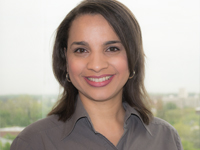 Name: Stephanie Anderson
Name: Stephanie Anderson
Title: Arts in Corrections Program Manager
Stephanie oversees the activities and contracts for our Arts in Corrections initiative, which brings rehabilitative arts programming to the inmates at every state correctional facility. Her day-to-day work is a testament to the power of the arts and serves as a big source of motivation for her: “Individuals who have gone through struggles in life and were able to overcome them, as well as those that have yet to overcome their challenges, inspire me to want to do more in this world.”
Another way she gains perspective? Through a telephoto lens. Stephanie recently bought herself a camera and has been putting it to good use with her newfound passion for photography. When she’s not taking pictures, she’s spending time with her son, Silas, occasionally indulging in some chocolate and/or Mexican food.
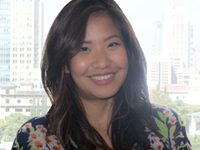 Name: Lariza Barcena
Name: Lariza Barcena
Title: Administrative Analyst
Lariza’s the staff liaison to our Council members and gives admin support to our executive staff. She’s also a walking passport to multicultural delights! Lariza was born and raised in Italy, and her parents are Filipino. Her upbringing helped her become fluent in four different languages—Italian; Tagalog; English; and Ilocano, a Filipino dialect. She can converse in Spanish and French, too! It’s second nature to Lariza to immerse herself in all this big blue marble has to offer, and she does—by plane and by palate, traveling and sampling the local cuisine wherever she goes.
She’s also a talented dancer, trained in ballet, jazz, Filipino folklore dance, and hip-hop—her current love. She performs at sports games and other major events along with her crew, Boogie Monstarz, whose founder is one of the original Jabbawockeez!
Her guilty pleasure? No such thing. “I don’t feel guilty about them! Ha!”
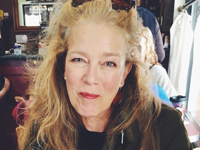 Name: Anne Bown-Crawford
Name: Anne Bown-Crawford
Title: Executive Director
You had an opportunity to get to know our director when she was first appointed by Governor Brown, but why pass up the chance to dig a little deeper? First, the job: As our director, Anne is responsible for agency administration and implementing the mission and the strategic vision of the CAC.
Now for the woman behind the work: Anne balks at the idea of choosing a favorite color. “An unfair question for an arts-immersed person!” she argues. But she doesn’t hesitate to declare her love for her five children, or her two dogs, Sadie and Kali. Anne grew up in Chicago with her four siblings, where activism was deeply instilled in her by her father, an ardent community organizer, still networking to this day. Her mother was a special education teacher. It makes all too much sense, then, that she would find the perfect hybrid of these two labors of love in her work here at the CAC, championing creative expression and lifelong learning for all as the centerpiece for healthy and happy communities.
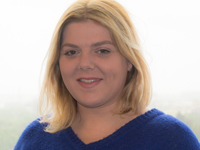 Name: Kimberly Brown
Name: Kimberly Brown
Title: Public Affairs Specialist
Kimberly—or Kim—is our communications coordinator, handling CAC’s press and outreach efforts (she may or may not have written this blog). While not an artist herself, Kim has always had a deep love for the arts and their role in understanding the nature of humanity. She studied art history in college, has played host to a variety of gallery events, and served as a volunteer docent for galleries and museums. “It’s incredibly fulfilling to be able to meld my professional skills and my personal passions through my work here at the California Arts Council,” she says.
Beyond art, her interests are all over the map—old-school soul and R&B, etymology, perfecting the baked potato—matching up well with her favorite quote, from playwright and provocateur Oscar Wilde: “Consistency is the last refuge of the unimaginative.”
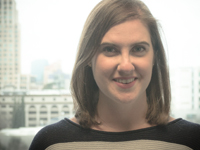 Name: Caitlin Fitzwater
Name: Caitlin Fitzwater
Title: Director of Public Affairs
Caitlin comes to us from the East Coast. Raised in rural Western Maryland, she attended college in Baltimore and then gave into the allure of New York City, as so many young theater people are wont to do. Caitlin worked in nonprofit theaters in the Big Apple for several years before following another passion and bringing her talents to the world of public radio. She then made a pit stop in Washington, D.C. before California, Sacramento, and the CAC came calling in 2013. She’s been managing our communications, marketing, partnerships, and public events ever since. Recently, she took on her newest role as mom to her son Finn, now just 8 months old! She enjoys spending her free time in support of her husband’s woodworking business and traveling whenever possible—including a trip to Italy in the not so distant future.
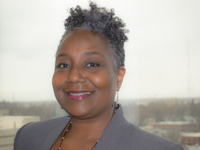 Name: Ayanna L. Kiburi
Name: Ayanna L. Kiburi
Title: Deputy Director
As Deputy Director, Ayanna serves as primary advisor to the Council and to our director, and is responsible for oversight of administration and program operations. Her background in public health gives her a unique perspective that allows her to hone in on strategies and opportunities where the arts and well-being intersect.
Ayanna was raised in the company of art and artists. Her father, part of the San Francisco Artist Guild, regularly took her on his travels to sell his work. Ayanna finds her own creative outlets through kinetic work, using her hands and body to dance, sing, and sew. She admires dancer Judith Jamison “for her story of triumph” and her rise to leadership as Artistic Director of the Alvin Ailey Dance Company.
Ayanna’s name is derived from Swahili. She took this name, along with her other family members who adopted their own Swahili titles, during the Black Power Movement of the 1970s.
 Name: Kala Kowtha
Name: Kala Kowtha
Title: Information Technology Specialist
Kala was born and raised in India, and came to the U.S. for graduate studies in the 1990s. In that time, she’s met her husband, gotten married, had two kids, and become our go-to for all things tech. Kala enjoys her work here at the Arts Council because she gets a better understanding of the arts and, by extension, “a better understanding of the abstract in people.” She’s inspired by the good in others, and urges everyone to consider being an organ donor, having donated a kidney herself 18 years ago to a family member in need.
One last fun (and fitting) fact she shared with us just recently: In Hindi, Kala means “art.”
 Name: Laura Littlefield
Name: Laura Littlefield
Title: Associate Governmental Program Analyst
Laura is our newest staff member, handling administrative work for internal operations and serving as our Small Business Liaison. She’s also a voracious reader, and will happily take any recommendations sent her way. Laura grew up in Humboldt County, and met her would-be husband there while working at a mom-and-pop restaurant as a high-schooler. The couple just celebrated their 20th anniversary last month! And their love of art was not to be left out of the celebration of their love for one another: Her and her husband made a visit to the small town of Mukilteo in Washington to see a piece of art at the local library, “because for years now it has served as a metaphor for our relationship and the ways we make each other better.”

Name: Kristin Margolis
Title: Director of Legislative Affairs
We’re an active bunch here at the CAC, but Kristin is the clear frontrunner for the most FitBit steps acquired in any given day. As our liaison to the Capitol, she racks up the miles on the pedometer with her near-daily trips to the dome to talk with Assemblymembers, senators, constituent groups, and the governor’s office, keeping tabs on relevant legislation and spreading the word about the benefits of the arts.
Kristin’s favorite fruit—cherries picked fresh from the tree in her yard—should be ripening in the springtime sun as we type. When she’s not enjoying them a la carte, she’s baking them into a pie—one of her beloved hobbies, along with skiing and painting. If you’ve called her office, paged the Capitol, barked up the local fruit trees and she’s still nowhere to be found, she’s most likely fitting in some family time with her two teenage sons, playing basketball, swimming, or cooking.
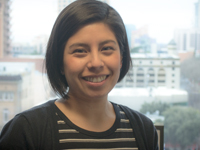 Name: Wendy Moran
Name: Wendy Moran
Title: Graphic Designer
Wendy’s our resident graphic designer, making the rest of us look good by way of her bold colors and polished aesthetic. Her favorite artist is Milton Glaser, who she admires for his clean lines and simplicity that have no doubt inspired her work. Glaser once said, “There are three responses to a piece of design – yes, no, and WOW! Wow is the one to aim for.” Wow is a word that’s always on our lips with your creations, Wendy!
Wendy’s got a side hustle as keeper of the office candy dish. Sweets are her favorite treat, and she benevolently assuages fellow staff’s sugar cravings with an oversized apothecary jar well-stocked with goodies. Plus, she frequently surprises us with pastries in the morning. Wendy, you spoil us!
And with that, you’ve gotten to know each and every one of the staff here at the California Arts Council. We’re here to serve! Don’t hesitate to reach out to whomever best can address your needs.

California Poetry Out Loud: And the winner is…
“And our winner for this year is …”
Council Chair Nashormeh Lindo smiles before making the big announcement, as a bevy of excited high-schoolers break into a spontaneous drum roll on the Assembly floor.
The 2018 California Poetry Out Loud recitation contest has come down to this moment.
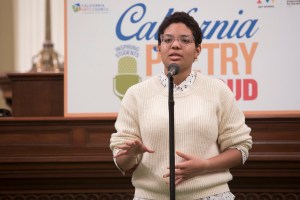
“… Alexis Rangell-Onwuegbuzia!” Lindo finishes with enthusiasm.
The reaction of the room speaks volumes. As cheers erupt on the floor and spread to the gallery above, it’s clear Alexis was a fan favorite, winning the approval of her peers as well as the judges. In a venue like the historic Assembly chambers, where decisions are made each day by representatives of the electorate, the occasion feels fittingly democratic.
An initiative of the National Endowment for the Arts and The Poetry Foundation, administered by the CAC, Poetry Out Loud offers teens the confidence to make themselves heard, with poetry as their medium. Contestants get the chance to better understand and connect with the work of the masters through their own unique interpretation and delivery.
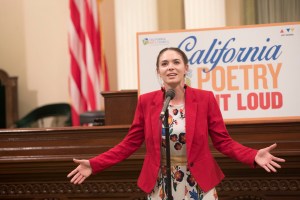
Over the course of the two-day final competition, Alexis captured the hearts and minds of her observers, reciting three poems with style and precision: “If They Should Come for Us,” by Fatimah Asghar, “Chorus Sacerdotum,” by Baron Brooke Fulke Greville, and “The Mortician in San Francisco,” by Randall Mann.
The Orange County senior from Mater Dei High Shcool explains her relationship with poetry as a tool to promote social change on a civic level and within the world of art itself. “The arts give me the courage to express my values with an activist’s voice in the midst of the fear and ignorance residing on both sides of the ‘fourth wall,'” she said.
Sacramento County senior Sage Innerarity of Pleasant Grove High earned the prize of runnerup. Nicholas Panyanouvong, a sophomore at James C. Enochs High in Stanislaus County took third place for the second year in a row.
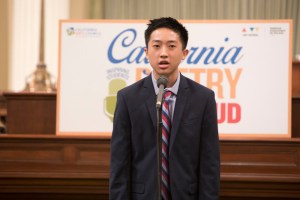
Poetry Out Loud is a statewide combined effort—this year involving the participation of 46 counties and 261 schools, the encouragement of 783 teachers, and the dedication of 30,000 students. It takes a panel of knowledgeable judges, a cadre of CAC Council Members and staff, a guest appearance from California Poet Laureate and POL founder Dana Gioia, and the backing and encouragement of countless legislators—just to name a few.
But the county finalists are no doubt the stars, and not only for their onstage presence. Their enthusiasm for one another out of the spotlight is all the more extraordinary, as heard in that volcanic moment on the Assembly floor.
“That’s what I love so much about Poetry Out Loud,” explained Chair Nashormeh Lindo. “It is the young people’s camaraderie and genuine support of one another that makes it so much more inspiring. It makes me hopeful, seeing their authentic humanity and respect for one another.”
Alexis will go on to represent California in the national finals next month in Washington, D.C., on April 23-25. We’ll have all the details for you to tune in and watch coming soon.
Congratulations to this year’s winners, and to all the county champions!
For pics, videos, and more from the final event and the state POL program, visit our online HQ for all things California Poetry Out Loud: http://arts.ca.gov/initiatives/pol/index.php.

From the director’s chair: An interview with the CAC’s Anne Bown-Crawford
Just before the new year, we got some great news: Governor Jerry Brown had appointed a new director to head up the CAC, Anne Bown-Crawford. Anne is a champion for arts education in California and a leading arts advocate with a sphere of influence stretching from her local school district in Humboldt County to the international stage.

Anne’s been with us for nearly a month now, and the Council and staff have been delighted to work with her and get to know her better. Now it’s time to dish a little deeper to you! We asked Anne a handful of questions to shine more light on her background in arts education and community service, her thoughts on the future of the arts field, and the tasks and challenges ahead for the CAC—as seen from the director’s chair.
The mission of the CAC’s is to advance California through the arts and creativity. What is your personal mission for the arts, and how does it impact your professional one?
Connecting young people to their voice and nurturing in them the agency to make connections between the social and cultural contemporary issues that shape their lives has always been of personal and professional importance to me. In my mind, making those connections is crucial to their success in the 21st century. Our communities as a whole, including our youth, need creative strategies to become proactive instead of reactive within their culture. By reducing the sense of alienation and fragmentation found in contemporary society, we can best nourish healthy communities.
I hope to continue and expand this commitment to the California Arts Council’s programs and initiatives in ways that are consistent with CAC’s mission, vision, and values.
I feel particularly inspired by the CAC’s work in strengthening respect for cultural heritage and advancing racial equity and in nourishing arts education in schools and communities, and even within the California Department of Corrections and Rehabilitation. These actions are essential for our civil society’s health.
A strong, inclusive, and thriving civil society then positively impacts our entire state, including the economic and governmental landscape.
You are a champion for arts education. How will that play for you as director of the CAC?
Building arts education models has been a hallmark of my career. The most effective models have been partnerships based on collaboration, both within educational institutions and in community arts settings, that connect to the economic development of the region and the state. These partnerships concentrate on robust learning and the transferable skills needed to promote innovation, economic growth, and creativity. I look forward to doing the same type of work at the CAC, and more!
For me, meaningful, creative education sits at the center of so much, it touches every aspect of CAC’s work, whether it is in corrections, cultural districts, or community arts organizations. It sits at the center of a healthy community overall.
You are also a big proponent of technology, which has a long and rich relationship with the arts. In the postdigital era, what kinds of innovations in the arts have you seen that excite you?
I love the way technology has added to the tool sets available to artists. It has expanded our vision. I also delight in the fact that so many artists are involved with designing the digital devices, interfaces, etc. that we all use every day. We all hold art right in our hands, all the time! Technology offers ways to stretch the old boundaries of making and creating in very exciting ways. Being able to combine programming with two, three, four dimensions, in time-based art, offering up unusual solutions to creative challenges is inherently fascinating to me. Those art forms range from the sonic to virtual reality, to visual images changed and created with digital data, to completely immersive sensory experiences. And, ultimately, technology has the ability to make art more accessible to wider audiences, both as creators and consumers.
What is one surprising thing you’d like for the arts field to know about you?
Well, that’s a tough one, since I’ve been living my life for the past four decades in front of an audience, whether in a classroom or out in the community. Perhaps some folks around the state might not be aware of the fact that I not only have a visual art studio practice, but I played lead drum (tenor) in a steel drum orchestra for many, many years, and was taught by Ray Holman, one of the masters of the steel drum from Trinidad, a frequent guest of Humboldt County.
What strengths do you see in the work of the agency? What challenges lie ahead?
The strengths I see in the work of the CAC are well reflected in the lenses we use to focus the work: building public will for the arts; equity—ensuring that California’s diverse populations are always reflective in the work and accessible to all; serving as the leading authority and champion for the arts in California, regionally and nationally; and working to ensure that standards of excellence, relevance and effectiveness sit at the center of all of our programs and services.
Perhaps the biggest challenge, aside from trying to survive political currents, is how to serve and have a meaningful impact in every sector of this huge state. There is so much diversity, so many underserved populations, and—to put it simply—so much geographic territory to pay careful attention to in California, that can seem daunting. At the same time, as the sixth largest economy in the world, California is home to an amazingly vibrant and robust creative economy. That economic landscape, that pervasive feeling that we can be nimble and innovative while lifting up the diversity that makes California so unique, will help nourish and connect our work here at the CAC.
The fun final question: If you were hosting an intimate dinner party, and could invite any three people, living or dead, who would they be, and why?
Jim Bown, my father, because he has taught me well how to follow my dreams, work hard, be an effective public servant/leader, and how to be a compassionate mother. President Carter, for his life-long commitment to humanitarian work around the world. And Michelle Obama, because of the strength, lively spirit, sharp intelligence, and good grace she demonstrated in her role as a leader during the Obama administration. And I’d really love to talk about what comes next for her!
And then, since I really believe in filling out a table, I would add Ruth Bader Ginsberg, for her vibrant opinions on the strength of women in our society; Jerry Seinfeld for his great good humor and ability to draw good humor from others; and Paula Scher, because of her remarkable, articulate work in design, blurring the line between pop culture and fine art in her work as a graphic designer, painter, and art educator.

Meet the CAC Staff, Part 2
It’s time for another blog where you get to know the CAC staff! Since we’re deep in the throes of grant season around here, part two in our series introduces the amazing Programs staff that coordinates the 15 different grant programs we offer.
 Name: Hilary Amnah
Name: Hilary Amnah
Title: Arts Program Specialist
First on the roster is our newest addition to the Programs team! Originally from the Hocking Hills of Ohio, Hilary has a passion desert landscapes and for artist-led, collaborative community projects. She had the chance to contribute to a mural of influential women in history called “Work in Progress,” led by pop artist Jann Haworth, featuring portraits of Ruby Bridges, Queen Elizabeth, Marie Curie, Jane Austen, and many more.
On a sillier note, we have a passion for the ambiguous conviction of her answer to the question, “What’s your favorite food?”
“Probably pizza,” she said. “But it has to be good pizza.”
Hilary coordinates the Creative California Communities, Cultural Districts, and Arts and Public Media programs.
 Name: Jaren Bonillo
Name: Jaren Bonillo
Title: Arts Program Specialist
Jaren is our resident photographer. She holds a BFA in Visual Arts with a photo concentration and an MFA in photography. She uses her talents to document her frequent travel adventures—most recently to Denmark, Sweden, and Colombia. Her favorite artist? Marcel Duchamp. “For his ability to innovate and communicate through a broad range of artistic mediums and processes,” she said. Jaren also loves hiking and exploring new restaurants.
Jaren coordinates our State-Local Partnership program, Statewide and Regional Networks, Professional Development, and Organizational Development programs.
 Name: Shelly Gilbride
Name: Shelly Gilbride
Title: Programs Officer
You know you’ve got a great staff when one of your favorite recent travel memories involves a canceled flight and co-workers. “Andrea, Hilary and I had an amazing adventure driving back to Sacramento from San Bernadino. Podcasts, good company, and a stop for delicious tacos made the trip,” said Shelly. So sweet! But what about when we asked what she’s up to when she’s not working? “Parenting!” she replied. “But even then, it STILL involves art!” She also makes time for her favorite pastimes: modern dance, yoga, and running with her early morning running buddies.
Shelly heads up the program team, directing implementation of grant programs and special projects, and overseeing grant review panels. She also coordinates the Reentry through the Arts program.
 Name: Jason Jong
Name: Jason Jong
Title: Arts Program Specialist
Jason is a force here at the CAC, and the story’s no different outside the office. He’s the executive producer of the Sacramento Asian Pacific Cultural Village and the Sacramento Asian Pacific Film Festival, a talented percussionist, and a father of three, for starters. He also serves on several local community boards, but hopes to find more time this year for the out of doors, hiking, kayaking, and camping.
Jason coordinates our Veterans in the Arts and Cultural Pathways programs, and facilitates our partnership with the National Arts and Disability Center to administer the Arts and Accessibility Technical Assistance program. His technical prowess has also proved invaluable support to the program staff in our move to a new online platform for grant applications.
 Name: Josy Miller
Name: Josy Miller
Title: Arts Education Program Specialist
Josy shared a story with us that sums up her passions and personality so well, we figured we ought to just pass her the mic: “My great-aunt Judith, a very important figure in my life, took me to Paris when I was 15, and I was completely changed. In addition to taking me to the Ballet Opera of Paris and too many world-class museums to name, she taught me what true beauty and pleasure one could experience around the dinner table. The arts and food have been two centerpieces of my life ever since.” Her love of Shakespeare and stinky cheese have become so clear.
A mother of two boys, Josy is the lead on all of our arts education-oriented programs and initiatives, coordinating the Arts Education, JUMP StArts, and Research in the Arts programs as well as California’s Poetry Out Loud program.
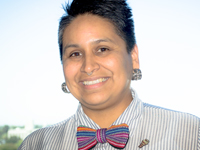 Name: J. Andrea Porras
Name: J. Andrea Porras
Title: Arts Program Specialist
Andrea’s favorite color is “rainbow.” We hope that conveys the slightest bit of the extraordinary life and color she brings to our world! Andrea shines from so many facets, we don’t know where to start. Emcee, Reiki Master, National Latino Arts & Culture leadership fellow, roller skater who learned to swim in the San Felipe Springs of her Texas barrio, her favorite work of art is her son’s “every improv.” Andrea is an avid volunteer who “lives to dance in service,” as she says. Fun fact: She was once a guest on a live television show in Mexico City where a medicine man performed a healing on her.
Andrea coordinates our Local Impact and Artists in Communities grant programs.
The Programs staff would collectively like to remind you to check out all the different grant opportunities that are currently open for applications! Deadlines are fast approaching for many of our programs. And be sure to reach out to the corresponding smiling faces of the above staff with any questions.
Coming soon: Part 3, the final entry in our Meet the Staff series!

Meet the CAC Staff, Part 1
Welcome back! We hope you all have had a fantastic start to your 2018 so far, taking time to make time, spending the holiday season with your friends and loved ones. In that spirit, we thought we’d kick off the first blog of the year with an introduction to our family at the California Arts Council, and give you a chance to learn a bit more about what they do and who they are. Part one begins with our administrative staff.
Name: Bintou Coulibaly
Title: Senior Accounting Officer
Bintou oversees the accounting staff and handles fiscal reporting to state control agencies. Born in the Ivory Coast, she says her move to the United States was one of her greatest life adventures. In addition to speaking English, French, and at least five different African dialects, Bintou has all the qualities of an incredible listener, often topped off with a witty reply. She enjoys reading, cooking, and playing soccer with her three children when she’s not here with us—though if you ask her what she does outside of work … here comes that wit we mentioned: “Sleep.”
 Name: Richard Diaz
Name: Richard Diaz
Title: Receptionist
Richard’s our go-to guy for all the office needs—fielding and directing calls from our main phone line, delivering the mail, purchasing office supplies, and storing CAC records. When he’s not representing at reception, he spends his time off working on model planes and cars, or playing old-school video games. He also enjoys the company of family and friends, furry incarnations included. Richard has three dogs: Scooby, Shaggy, and YoYo.
 Name: Jared Hamlin
Name: Jared Hamlin
Title: Accountant I
Jared’s part of our accounting staff, processing payments to our grantees. Some quick math about Jared: His favorite colors (green and orange) + his favorite food (pizza) = Michelangelo. As in his favorite Ninja Turtle, not the Renaissance artist—our interests can sometimes stray from the more obvious, you know! Jared’s also recently married. He and his newly betrothed just moved to a new place in order to add a dog to their current two-cat lifestyle. Congrats, JareBear!
 Name: Yurika Jimenez
Name: Yurika Jimenez
Title: Accountant I
Yurika is without a doubt the owner of the sunniest disposition of the CAC staff, with a smile that may require UV protection. She also loves the color “pink!” and eating “sushi!” (both followed by enthusiastic exclamation points in the staff survey—you see what we mean?). As one of our accountants, she’s got a head for numbers… and so much more. In a recent staff meeting, we were delighted by this diva’s operatic rendition of the birthday song. Move over, Marilyn!
 Name: Mariana Moscoso
Name: Mariana Moscoso
Title: Arts in Corrections Program Analyst
Mariana’s administrative specialty lies with our Arts in Corrections program, coordinating contracts, program development and monitoring. Her interests in life, however, are less specialized, more just special. Mariana is deeply inspired by tradition, with her Afro-indigenous roots shaping her understanding and place in the universe. She speaks four languages—English, Spanish, German, Italian—and is working on a fifth, Tz’utujil. Mariana recently participated in the WESTAF Emerging Leaders of Color Cohort, and has an impressive collection of bead jewelry and a cat named Machiavelli. How cool is all of that? We say very.
Name: Nicole Sanchez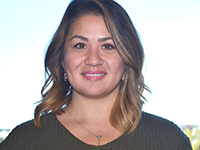
Title: Procurement and Contracts Analyst
“Enjoy the little things, for one day you may look back and realize they were the big things.” That line, by Robert Brault, is Nicole’s favorite quote, and it sums up her life philosophy well. Nicole’s responsible for agency contracts and procurement activities here at the office, but at home, she’s responsible for her two young sons, ages 8 and 13, who she says inspire her every day to be better. She often serves as Team Mom or even Coach for whatever sport is in season. “Their hobbies are my hobbies!” she adds. Except for her love of skydiving—the boys will have to wait until they are a bit older for that one.
Name: Debra Waltman
Title: Director of Administrative Services
Debra heads up the aforementioned administrative support staff while also handling all things budget, in addition to contract completion, interagency agreements, and purchasing. Outside the office, the music maven makes time to teach herself guitar, check out concert scene and serve on the Girls Rock Sacramento Advisory Board. Debra’s attitude about her team, and of all of the staff at the CAC, is a fitting close to Part 1 of our Meet the Staff series:
“One of my favorite things about the Arts Council is the culture. We are all open and accepting of each other as individuals—not just as co-workers.”
Well said.
Stay tuned for Part 2 of our Meet the Staff series, coming soon!
Arts Council Vice Chair shares poem on wildfires at NASAA Leadership Institute
At the California Arts Council, Council members and staff certainly aren’t limited to wearing only one hat when it comes to their relationship with the arts. Whether it’s dance, music, film, literature, visual or performing arts—creativity thrives here.
A recent moving example comes from our Council Vice Chair Nashormeh Lindo. Last month, while attending the National Assembly of State Arts Agencies Leadership Institute in Portland, Lindo took the opportunity to represent our state by sharing a heartfelt poem she penned about the recent wildfires in Northern California. The text of the poem is below.
California Wildfires.17
They came,
crept up on us,
in the middle of the night.
In darkness, 
the Diablo Devil winds
fanned flames,
Sending spooky sparks
Ember imps, flying over hilltops and trees,
and skittering across roads, highways and boulevards.
Spreading mischief, conjuring up evil and
creating a haze of dry orange
smoky, choking air.
California dreams turned nightmarish.
It is unrelenting.
Everything is burning.
Words like, apocalyptic,
devastation, scary,
other worldly
Moonscape
come to mind.
It is the scorched Earth.
Come back to haunt us.
A desolate landscape is all that is left.
People, trees, homes, vineyards,
Gone.
Days later while
Escaping
Fleeing, in search of cleaner air
One can still see plumes of
terrifying toxic smoke
From the air.
The fires rage on.
It’s hard to breathe
particulate.
I think of
Kingsolver’s words:
“The fire ran ahead at times, and sometimes flagged, as if growing tired like the rest of us. The heat was unspeakable.
I imagined the taste of water.”

Dazed people gaze at each other;
and at their charred and ruined things,
after fleeing terror in the middle of the night,
and tracing the tracks of sooty tears,
Days, spent in evacuation despair.
Loss, exhaustion, raw grief and disbelief
makes us all equals.
Makes us care,
What will rise from these ashes?
Belief in Healing Hope.
The Courage to Create
To rebuild with the innate tools of
Music, Poetry, Dance,
Theater, Painting, Photography.
Mapping the path back,
to see beyond the seeming
Abyss.
Nashormeh Lindo
10/12/17
Portland, Oregon
(Excerpt from the Poisonwood Bible, by Barbara Kingsolver)

Top 3 Reasons to Be a California Arts Council Panelist
As winter approaches and 2017 draws to a close, the staff and council at the CAC are busy thinking ahead to next year! We’re on a quest for the best and the broadest minds in the field to serve on peer-review panels for our grant programs in the first half of 2018.
As an artist, arts administrator, policy maker or activist, that means you!
Here’s how it works: Each spring, applications to our grant programs are reviewed by a panel of three to five arts and culture experts. Panelists independently read and review between 30 and 60 applications via our online portal, then come to our offices in Sacramento—travel expenses paid—for one to three days to collaboratively rank applications. The rankings are brought to our Council members to inform funding decisions.
That’s the who/what/when and where for you. Now comes the why.
Why should you be a part of our panels? Here are the CAC’s top three reasons you should apply today:
1. It’s good for us.
This is the more obvious one, hence its place at the top of the list. No question, you’re doing us a solid by participating. We literally can’t do this without you. It’s crucial that grant application evaluation is unbiased, considered by groups with varied backgrounds, identities, and knowledge bases. Our conference room of panelists will ideally match the demographics of our state (minus nearly 40 million people, plus a dozen bagels).
2. It’s good for you.
Joining one of our panels isn’t just a benefit to us, there’s a major upside for you, too. It’s a fantastic opportunity to network with your peers in the field, to gain insight on a wide array of arts organizations while reviewing, to glean suggestions for your organizations over lunch. It’s also a great way to broaden your perspective on the arts in California, soaking up ideation and creativity; gaining exposure to different business models and leadership styles; gauging potential and community impact. Every learning is a chance to reignite and reinvigorate your own mission and values as part of the creative community. Don’t just take our word for it—this guest blog from one of last year’s panelists comes to the very same conclusions.
3. It’s good for California.
When you help us to enrich the lives of those who live in our state by access to and participation in the arts, it’s a good thing. When you emerge newly inspired to do the same, it’s a good thing. When our grant applicants receive expert evaluation to ensure maximum benefit to their communities, it’s a good thing. Being a panelists is a win-win-win situation that leaves us all better off. Apply now!
A Message for Grantees and Artists Affected by the Wildfires
The California Arts Council is deeply saddened by the devastation caused by the multitude of wildfires currently burning in Northern California. To our grantees, artists and their communities; to families and businesses in the region; and to all those affected by these traumatic events: Our hearts are with you.
In the wake of continued evacuations and the governor’s emergency proclamation yesterday, we are requesting that all CAC grantees in Sonoma, Napa, Lake, Mendocino, Butte, Yuba, Nevada and Orange counties please check in with our Programs staff via phone or email if you have not done so already.
The California Arts Council website features a page of resources for artists affected by the fires, also listed below:
Craft Emergency Relief Fund (CERF+): The Craft Emergency Relief Fund (CERF+) has emergency relief grants and interest-free loans available for eligible artists working in craft disciplines. Guidelines and eligibility are available on the CERF+ website. The application process is quick and easy, with a rapid response of 2 weeks to give artists the help they need as soon as possible.
The Joan Mitchell Foundation: The Joan Mitchell Foundation’s Emergency Grant Program is available for visual artists who have suffered physical losses due to a natural disaster that relate to their artistic practice. Click here to learn more.
MusiCares: MusiCares provides a safety net of critical assistance for music people in times of need. MusiCares’ services and resources cover a wide range of financial, medical and personal emergencies, and each case is treated with integrity and confidentiality. A directory of resources for musicians and other artists is available on the MusiCares website.
CAL FIRE: The California Department of Forestry and Fire Protection (CAL FIRE) is our state’s go-to resources for up-to-date wildfire information and resources. www.calfire.ca.gov
Studio Protector: An artists guide to emergencies. A wealth of information on emergency readiness for all artists can be found at www.studioprotector.org.

Reflections on the Americans for the Arts Convention
During an unseasonably warm weekend mid-June in San Francisco, more than 1,200 arts and culture workers gathered for the annual Americans for the Arts Convention. Hosted locally by the San Francisco Arts Commission, the convention provided a great opportunity for the California Arts Council programs staff to network with their peers, connect with grantees and learn more about the issues that impact our work to support creativity and culture across the state.
Upon return from the Bay, members of our staff were gracious enough to reflect on the experience and jot down their thoughts on what would be most helpful for the field!
Shelly Gilbride, Programs Officer:
Take-away #1: Foster evaluation from within – honoring the curiosity, explorations and intellect of artists and participants.
One of the sessions that inspired and energized me the most was one on … EVALUATION! Oh, I hear the virtual groans from all of you grantees and applicants. I hope you will read on, because these toolkits and resources from Animating Democracy are very cool and super useful. The Aesthetics Perspective Initiative is an 11-pronged framework that can give artists, arts organizations, funders and supporters a common language to unpack conceptualizations of “artistic merit” or “artistic excellence,” addressing the dominance of Eurocentric aesthetic standards, and acknowledging that artistic merit is relative to the community where the creative work is situated, as well as the work’s intent and goals. Check out the Companion Guides for artists, funders, evaluators and curators. I am still thinking about how to apply this framework to the CAC’s grant programs. Certainly it is food for thought as our staff and Council continue to assess review criteria for our grant programs.
Josy Miller, Arts Education Programs Specialist:
Take-away #2: Diversifying arts leadership relies on pre-professional development from within the field.
The dynamic session on “Building Next Generation Leadership in Arts Education,” facilitated by Tamara Alvarado of the School of Arts and Culture at the Mexican Heritage Plaza (a CAC grantee!), included a multiplicity of voices from around the country discussing how to foster emerging arts education leaders. Perspectives were diverse, and specific strategies reflected important differences in organizational goals and contexts, yet a single refrain emerged over the course of the discussion: Young leaders must be fostered from within.
Both veteran and emerging leaders shared personal histories on how they got their starts, not only in the arts, but as arts leaders. Time and again, these stories included instances in which the individual had been invited and encouraged to take on high order tasks and duties. Crucially, these were not lessons, but rather actual chances to develop and implement projects that had real organizational consequences. The potential for failure hovered, mitigated by the presence of a mentor that supported, but did not direct their mentee’s process and decision making. These opportunities not only imbued those young people with the skill sets necessary to evolve into successful arts leaders in the future, but cultivated their understandings of themselves as leaders already.
Americans for the Arts is currently crafting a toolkit for arts education leadership development, which is set to be released in January, so certainly keep your eyes out for that. In the meantime, we at the CAC invite you to partner with us in fostering leadership talent from the ranks of amazing young people that are already in our midst!
Jaren Bonillo, Arts Program Specialist
Take-away #3: Model new forms of action, change narratives, share stories, and be of service to others.
On my way to the opening AFTA plenary, I took a photo with my phone of one of the texts of the 11 artistic attributes on display from the Aesthetics Perspective Initiative mentioned by Shelly above. I am not sure if it was the visual representation of the attribute or the title Disruption that caught my eye, but after reading,
“Art challenges what is by exposing what has been hidden, posing new ways
of being and modeling new forms of action,”
I used it as a mantra throughout the convention. The mantra continued to resonate as I listened to stories of civil unrest and injustices in Bryan Stevenson’s powerful keynote on his personal journey and the importance of changing historical narratives. Inspirational stories move me to tears—and laughter—and make me uncomfortable by challenging my worldview or triggering an old wound. Stevenson’s keynote delivered as such and was eloquently told as a classic tale of the “hero’s journey,” as popularized by Joseph Campbell’s monomyth. His speech invited us to be open, to dive deep into our personal and collective messiness—and come out the other side with transformational tools for being of service to others. These themes were further discussed in the “Talking About the Social Impact of the Arts” session. There was a generosity and vulnerability in the room of sharing personal and professional motivational values and how they drive us in our work and in practice to inspire and influence change.
My personal reflections, take-aways and observations from AFTA generate more questions than answers. Many of you may find the same as the field engages more with conversations around equity, diversity, and inclusion in our work and in our communities. In my own practice, I aspire to model the empathy needed to equalize and normalize the conversation around difference. And share and encourage stories! Sharing stories heals and serves the world—it connects us, rather than divides, and supports us to be in service to others, humanizes the work, and allows for new ways of seeing and being. For:
“the hero comes back from this mysterious adventure with the power to bestow boons on
his fellow [wo]man.” – Joseph Campbell